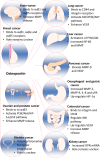The role of osteopontin in the progression of solid organ tumour
- PMID: 29500465
- PMCID: PMC5834520
- DOI: 10.1038/s41419-018-0391-6
The role of osteopontin in the progression of solid organ tumour
Abstract
Osteopontin (OPN) is a bone sialoprotein involved in osteoclast attachment to mineralised bone matrix, as well as being a bone matrix protein, OPN is also a versatile protein that acts on various receptors which are associated with different signalling pathways implicated in cancer. OPN mediates various biological events involving the immune system and the vascular system; the protein plays a role in processes such as immune response, cell adhesion and migration, and tumorigenesis. This review discusses the potential role of OPN in tumour cell proliferation, angiogenesis and metastasis, as well as the molecular mechanisms involved in these processes in different cancers, including brain, lung, kidney, liver, bladder, breast, oesophageal, gastric, colon, pancreatic, prostate and ovarian cancers. The understanding of OPN's role in tumour development and progression could potentially influence cancer therapy and contribute to the development of novel anti-tumour treatments.
Conflict of interest statement
The authors declare that they have no conflict of interest.
Figures




References
Publication types
MeSH terms
Substances
LinkOut - more resources
Full Text Sources
Other Literature Sources
Research Materials

